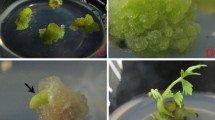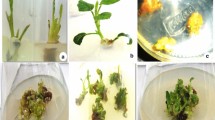Abstract
Persian poppy (Papaver bracteatum Lindl.) is an important commercial source of medicinal opiates and related compounds. In this research, calli were induced from seeds, roots, cotyledons and hypocotyls of P. bracteatum at a high efficiency. The optimized callus induction media consisted of the Murashige and Skoog (MS) basic media supplemented with 1.0 mg/L 2, 4-dichlorophenoxyacetic acid (2,4-D), 0.1 mg/L kinetin and 15 mg/L ascorbic acid. The concentrations of 2,4-D and ascorbic acid were found critical to callus induction and proliferation. Subsequent subcultures resulted in excellent callus proliferation. Ascorbic acid at concentration 15 mg/L increased the callus proliferation significantly. Maximum callus growth was achieved when the explants were incubated at 25°C. MS salts at full strength were found inhibitory for callus induction, while ľ MS salts were found to favor callus induction. Shoot regeneration of calli in vitro was achieved on ľ MS medium containing 0.5 mg/L benzylamine purine and 1.0 mg/L naphthalene acetic acid. Analysis of alkaloid extracts from Persian poppy tissues by high-performance liquid chromatography showed that thebaine accumulated in the tissues of plants. The thebaine alkaloid profile of the Persian poppy is a well-defined model to evaluate the potential for metabolic engineering of thebaine production in P. bracteatum.
Similar content being viewed by others
Abbreviations
- BA:
-
benzylamine purine
- 2,4-D:
-
2,4-dichlorophenoxyacetic acid
- DMR:
-
Duncan’s multiple range
- HPLC:
-
high-performance liquid chromatography
- MS:
-
Murashige and Skoog
- NAA:
-
α-naphthalene acetic acid
- SD:
-
standard deviation
References
Baskaran P., Raja Rajeswari B. & Jayabalan N. 2006. Development of an in vitro regeneration system in sorghum [Sorghum bicolor (L.) Moench] using root transverse thin cell layers (tTCLs). Turk. J. Bot. 30: 1–9.
Bentley K.W. 1971. The morphine alkaloids, pp. 3–163. In: Manske R.H.F. (ed.), The Alkaloids; Chemistry and Physiology, Vol. 13, Academic Press, New York.
Constable F. 1990. Medicinal plant biotechnology. Planta Med. 56: 421–425.
De Jong A.J., Schmidt E.D.L. & De Vriess S.C. 1993. Early events in higher plant embryogenesis. Plant Mol. Biol. 22: 367–377.
Dev S. 1997. Ethnotherapeutics and mordern drug development: the potential of Auerveda. Curr. Sci. 73: 909–928.
Gamborg O.L., Miller R.A. & Ojima K. 1968. Nutrient requirements of suspension cultures of soybean root cells. Exp. Cell Res. 50: 151–158.
Gang Y.Y., Du G.S., Shi D.J., Wang M.Z., Li X.D. & Hua Z.L. 2003. Establishment of in vitro regeneration system of the Atrichum mosses. Acta Bot. Sin. 45: 1475–1480.
Hazra S., Sathaye S.S. & Mascarenhas S.F. 1989. Direct somatic embryogenesis from peanut (Arachis hypogaea L.). BioTechnology 7: 949–951.
Ikuta A. & Itokawa H. 1988. Alkaloids of tissue cultures of Nandina domestica. Phytochemistry 27: 2143–2145.
Ikuta A., Syono K. & Furaya T. 1974. Alkaloids of callus tissues and redifferentiated plantlets in the Papaveraceae. Phytochemistry 13: 2175–2179.
Ilahi I. & Ghauri E.G. 1994. Regeneration in cultures of Papaver bracteatum as influenced by growth hormones and temperature. Plant Cell Tissue Organ Cult. 38: 81–83.
Komamine A., Kawara R., Matsumoto M., Sunabori S., Toya T. & Fujimura T. 1992. Mechanisms of somatic embryogenesis in cell cultures: physiology, biochemistry, and molecular biology. In Vitro Cell. Dev. Biol. 28P: 11–14.
Kutchan T.M., Ayabe S. & Coscia C.J. 1985. Cytodifferentiation and Papaver alkaloid accumulation, pp. 281–294. In: Phillipson J.D., Roberts M.F. & Zenk M.H. (eds), The Chemistry and Biology of Isoquinoline Alkaloids, Springer-Verlag, Berlin and New York.
Mendelsohn R. & Balick, M. 1994. The value of undiscovered pharmaceuticals in tropical forests. Econ. Bot. 49: 223–228.
Michalczuk L., Cooke T.J. & Cohen J.D. 1992. Auxin levels at different stages of carrot somatic embryogenesis. Phytochemistry 31: 1097–1103.
Murashige T. & Skoog F. 1962. A revised medium for rapid growth and bioassay with tobacco tissue cultures. Physiol. Plant. 15: 473–497.
Nakagawa K., Fukui H. & Tabata M. 1986. Hormonal regulation of berberine production in cell suspension cultures of Thalictrum minus. Plant Cell. Rep. 5: 69–71.
Osol A. & Pratt R. 1973. Dispensatory of the United States of America. Lippincott, Philadelphia, PA, 1292 pp.
Phillipson J.D. 1983. Intraspecific variation and alkaloids of Papaver species. Planta Med. 48: 187–192.
Rao A.Q., Hussain S.S., Shahzad M.S., Bokhari S.Y.A., Raza M.H., Rakha A., Majeed A., Shahid A.A., Saleem Z., Husnain T. & Riazuddin S. 2006. Somatic embryogenesis in wild relatives of cotton (Gossypium spp.). J. Zhejiang Univ. Sci. B 7: 291–298.
Rostampour S., Hashemi Sohi H., Jourabchi E. & Ansari E. 2009. Influence of Agrobacterium rhizogenes on induction of hairy roots and benzylisoquinoline alkaloids production in Persian poppy (Papaver bracteatum Lindl.): preliminary report. World J. Microbiol. Biotechnol. 25: 1807–1814.
Santacy F. 1970. Papaveraceae alkaloids, pp. 333–454. In: Manske R.H.F (ed.), The Alkaloids; Chemistry and Physiology, Academic Press, New York.
Skoog F. & Armstrong D.J. 1970. Cytokinin annual review. Plant Physiol. 21: 359–384.
Tyler R.T., Eilert U., Rijinders C.O.M., Roewer I.A., McNabb D.K. & Kurz W.G.W. 1989. Studies on benzophenanthridine alkaloid production in elicited cultured cell cultures of Papaver somniferum, pp. 200–207. In: Kurz W.G.W. (ed.), Primary and Secondary Metabolism of Plant Cell Cultures, Spring-Verlag, Berlin.
Wieczorek U., Nagakura N., Sund C., Jendrzejewski S. & Zenk, M.H. 1986. Radioimmunoassay determination of the six opium alkaloids. Phytochemistry 25: 2639–2646.
Yang J, Gong Z.C. & Tan X. 2008. Induction of callus and extraction of alkaloid from Yi Mu Cao (Leonurus heterophylus Sw.) culture. Afr. J. Biotechnol. 7: 1157–1162.
Author information
Authors and Affiliations
Rights and permissions
About this article
Cite this article
Rostampour, S., Sohi, H.H. & Dehestani, A. In vitro regeneration of Persian poppy (Papaver bracteatum). Biologia 65, 647–652 (2010). https://doi.org/10.2478/s11756-010-0079-6
Received:
Accepted:
Published:
Issue Date:
DOI: https://doi.org/10.2478/s11756-010-0079-6




